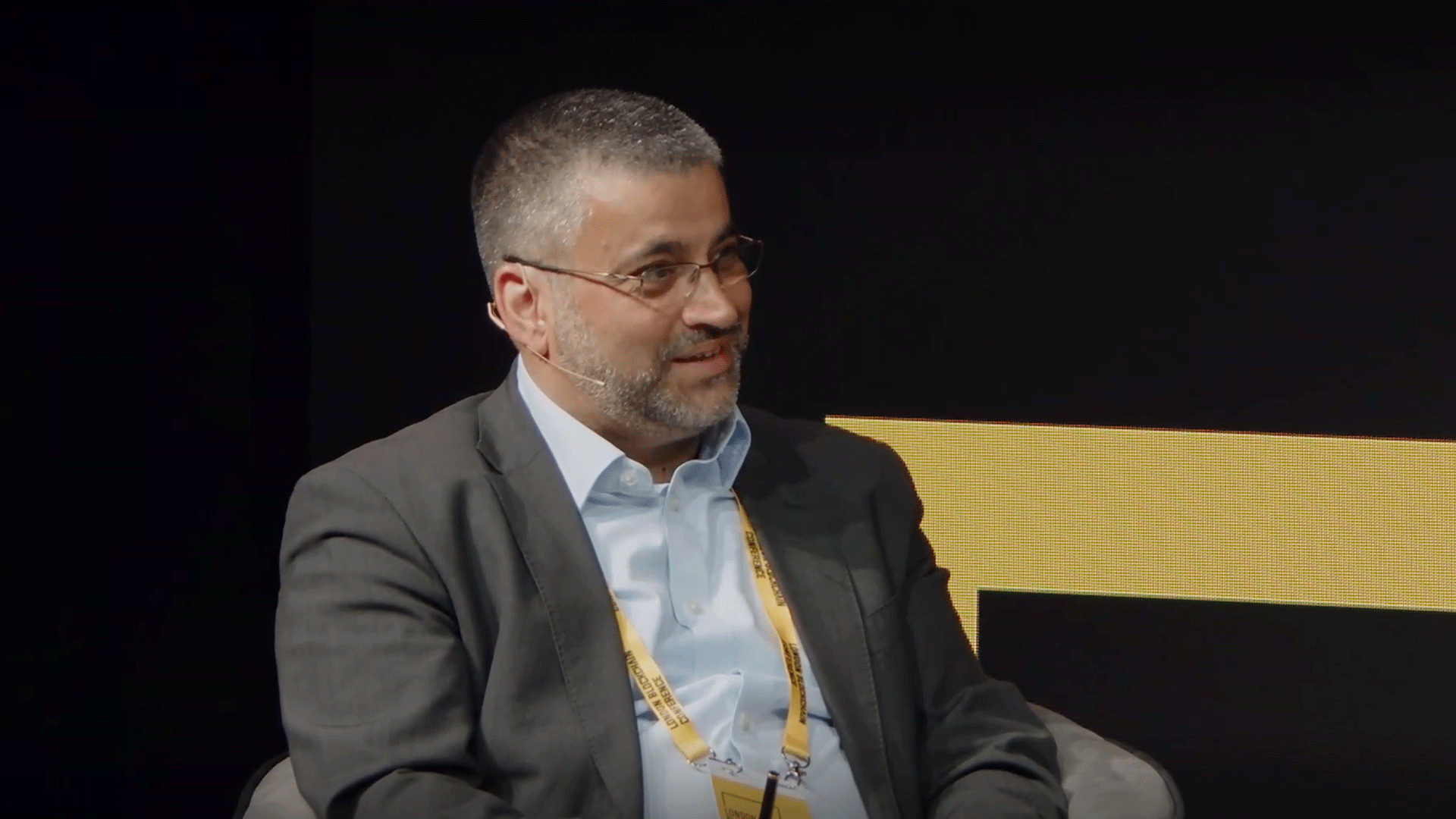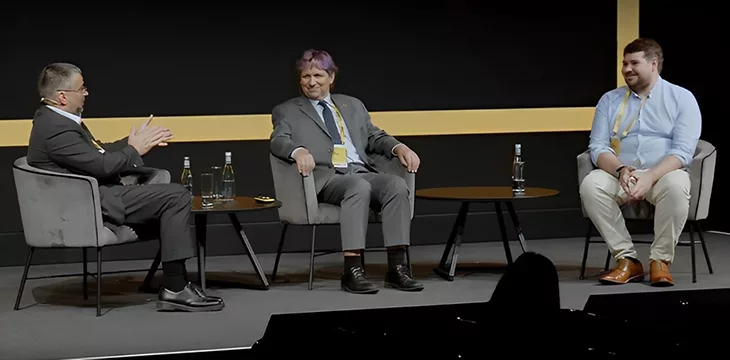[ad_1]
The dueling concepts of ‘blockchain for security’ and ‘security for the blockchain’ were unpacked during the opening panel discussion on the “Insight Stage” of the London Blockchain Conference 2024, with real benefits outlined but concerns about the looming future threat of quantum computing.
On May 21, the London Blockchain Conference 2024 kicked off with three days of panel discussions, speeches, demonstrations and presentations. The event was hosted in one of the cavernous exhibition halls of the ExCel Centre, the British capital’s premier conference venue—thanks to its location in the Royal Docks on the banks of the Thames and its endless supply of coffee stalls.
Early on the Day 1 agenda was “How Blockchain Technology is Reshaping the Cybersecurity Landscape,” a discussion hosted by John Velissarios, founder and director of Otranto Limited, an IT security consultant – so a man with skin in the game and no lack of experience when it comes to technical security issues.
After some brief introductions to the assembled attendees who filled the Insight Stage room – covered on all sides by black curtains that give the impression of an interpretive theater production in progress – Velissarios handed the microphone to Robert Huber, TechLead at Veridat, a SaaS platform provider that “streamlines the capture of critical data to a public blockchain.”

Providing security with the blockchain
Focusing on the ‘security of the blockchain’ side of the issue, Huber explained that with a myriad of business sectors, “the right decisions can only be made if the data is completely accurate.” This is where the blockchain and its characteristic immutability come into play.
He suggested that the blockchain provides “a layer of truth over existing data.”
“We record key events in the digital workflow in ways that make them immutable and timestamped. Because data is data, those solutions apply to any company, any business, anywhere,” said Huber.
He suggested that a lack of trust is a problem in the business world, and one solution to this is to generate a “lightweight integrated platform” to serve as third-party auditing, which is one solution that Veridat offers to clients.
Another of Veridat’s roles, Huber explained, was to insert itself into the supply chain. In doing so, the company is introducing security and data control systems for its customers “to add end-to-end transparency.”
He also gave some examples of use cases, the first related to trade compliance with the Lacey Act (1900/2008), a US wildlife protection law that makes it a federal crime to take any fish, wildlife or plants in violation of any law, treaty or regulation of the United States taken or sold—essentially trafficking in illegal wildlife.
Huber explained how Veridat’s system is used by companies to make sure all their products are traced from source and comply with the Lacey Act.


Another example relates to the pharmaceutical life cycle, which requires detailed and accurate information about the manufacturing process for the purposes of regulators – an area where Veridat can help by applying the blockchain.
“Regulatory compliance is not cheap to comply with, but non-compliance is more expensive,” Huber pointed out.
However, he concluded his presentation by explaining that his company is about “blockchain for security, rather than security for blockchain.” This is where the second panelist came into the conversation.
Security for the blockchain
After an opening that explored real-world cases of blockchain providing security benefits by adding “a layer of truth to data,” the panel turned to how you provide security for the blockchain itself.
Focusing on this very question, Joseph Kearney, research fellow at the University of Kent, began his talk by emphasizing that “you can’t have blockchain for security without a secure blockchain.” And as he explained, the blockchain is by no means beyond security concerns.
“I believe quantum computing will pose a serious threat to almost every blockchain we use,” Kearney warned.
This may seem a somewhat hypothetical dilemma, since quantum computing – a rapidly emerging technology that harnesses the laws of quantum mechanics to solve problems too complex for classical computers – is still a matter for research and development, not yet’ not a reality, and a long way from a widely available reality (if ever).
However, Kearney suggested that the threat is very real and perhaps not as far away as people think.
“When people ask when we’ll see quantum computers, the answer is always ‘fifteen years’ … but by 2030 we could very well be in a position where we have quantum devices,” he said.


“Essentially, digital signatures are vulnerable to attack, just like proof of work, from quantum computers… Unless we do something about it, it’s inevitable that we’ll see this type of attack.”
However, Kearney wasn’t entirely doom and gloom about the future of blockchain security, saying, “I believe that blockchain can be a shining beacon for the rest of the world” in terms of how it navigates this potential threat.
The future of blockchain security
Velissarios rounded out the panel by asking both speakers what people in the space should do to make blockchains more secure. To which Kearney suggested that every project starting today should keep post-quantum in mind and that any solutions are unfortunately “going to affect the efficiency of our blockchains, but this is the place to start.”
He concludes by going even further, suggesting that when it comes to dealing with these threats appropriately, “the point we will reach at some point is a choice between a slightly less efficient blockchain, or not having a blockchain” accompanied by the sound of worried murmurs and dozens of eyebrows being raised in unison.
Offering attendees a slightly more optimistic ending to cling to, Huber concluded simply by saying “it’s clear that blockchain digital records have a huge advantage in many different ways.” An important one, he said, is in the area of artificial intelligence, an area very much at the forefront of London Blockchain Conference 2024.
Looking at Cyber Security: Blockchain is a technology of trust
New to blockchain? Check out CoinGeek’s Blockchain for Beginners section, the ultimate resource guide for learning more about blockchain technology.
[ad_2]
Disclaimer for Uncirculars, with a Touch of Personality:
While we love diving into the exciting world of crypto here at Uncirculars, remember that this post, and all our content, is purely for your information and exploration. Think of it as your crypto compass, pointing you in the right direction to do your own research and make informed decisions.
No legal, tax, investment, or financial advice should be inferred from these pixels. We’re not fortune tellers or stockbrokers, just passionate crypto enthusiasts sharing our knowledge.
And just like that rollercoaster ride in your favorite DeFi protocol, past performance isn’t a guarantee of future thrills. The value of crypto assets can be as unpredictable as a moon landing, so buckle up and do your due diligence before taking the plunge.
Ultimately, any crypto adventure you embark on is yours alone. We’re just happy to be your crypto companion, cheering you on from the sidelines (and maybe sharing some snacks along the way). So research, explore, and remember, with a little knowledge and a lot of curiosity, you can navigate the crypto cosmos like a pro!
UnCirculars – Cutting through the noise, delivering unbiased crypto news








